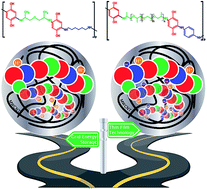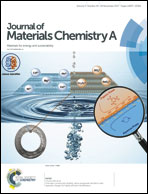Poly(quinone-amine)/nanocarbon composite electrodes with enhanced proton storage capacity†
Abstract
Novel redox active bi- and terpolymers, containing quinone-amine blocks and wired by nanocarbons have been synthesized and studied as negative electrodes for electrochemical proton storage. Two kinds of diamine (aliphatic and aromatic) were condensed with benzoquinone to enhance the storage capacity. The reaction between the benzoquinone and the diamines created an electroactive polymer displaying pseudo-faradaic proton transfer processes. Besides this transfer process, the aromatic diamine showed an additional reversible redox reaction, between the nitrogen atoms conjugated to the quinone molecule and the hydrogen ions. The incorporation of carbon conductive nanofillers with specific dimensionality provided an additional and straightforward strategy to maximize both the electron conductivity and the proton storage capacity of the polymers. Homogeneous dispersion of nanocarbon redox polymer particles in the composite (along with the creation of a polymer–carbon interphase) was essential, in order to maximize the proton storage capacity. A clear correlation between the nanostructure of the polymer particles, the dimensionality of the nanocarbons and the polymerization process was found. These low-cost redox polymers reached up to 230 mA h g−1 and 75 μA h cm−2 at 0.08 A g−1 in an aqueous-based electrolyte, paving the way for the use of these materials for technologies such as thin-film devices and grid energy storage.



 Please wait while we load your content...
Please wait while we load your content...